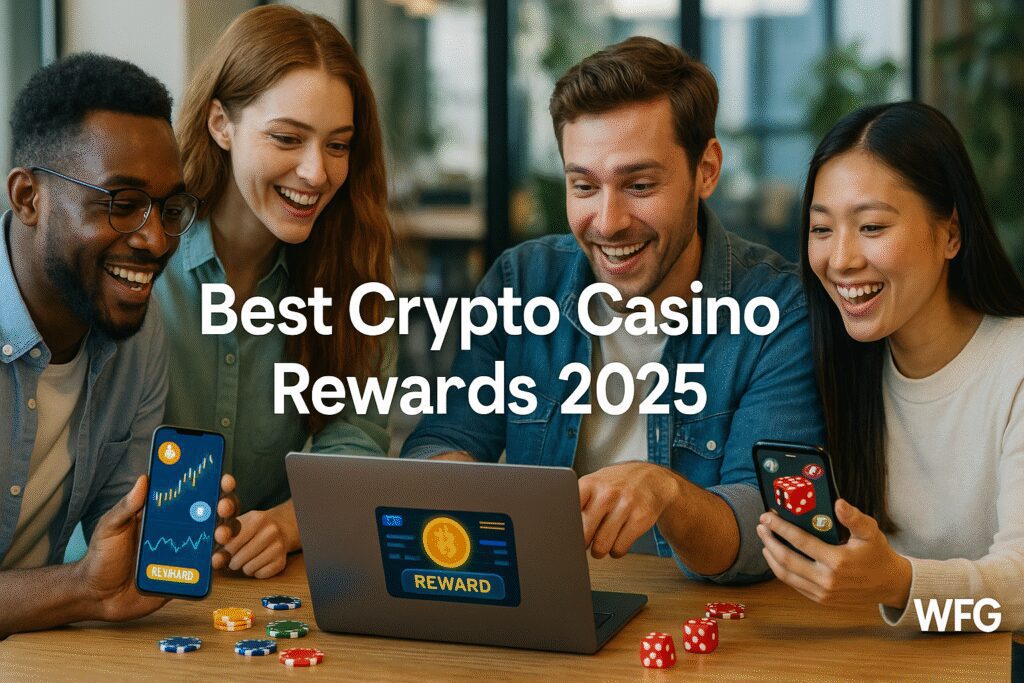Best crypto online casino platforms are revolutionizing the gambling industry by offering tokenized loyalty programs that provide real value beyond traditional point systems. These innovative platforms combine the excitement of online gaming with blockchain technology to create reward structures that actually appreciate in value over time.
The landscape of crypto gambling has evolved dramatically, with forward-thinking casinos now offering native tokens, staking opportunities, and governance rights to their players. Unlike conventional online casinos that trap your loyalty points in closed systems, crypto casinos provide transparent, tradeable rewards that extend far beyond the gaming platform itself.
Why Crypto Casinos Offer Superior Reward Systems
Traditional Points vs. Tokenized Rewards Comparison
Traditional casino loyalty programs operate on closed-loop systems where accumulated points hold no value outside the platform. These points often expire, cannot be transferred, and provide limited redemption options typically restricted to casino credits or basic merchandise.
Tokenized reward systems fundamentally change this dynamic by creating actual digital assets with real market value. Players receive cryptocurrency tokens that can be traded, staked for additional rewards, or held as investments. This approach transforms casual gaming into a potentially profitable activity where every bet contributes to building a valuable digital portfolio.
Outsourcing Video Game Development: A Complete Guide for Studios
The transparency inherent in blockchain technology also eliminates the black-box nature of traditional loyalty programs. Players can verify their reward calculations, track token distribution, and understand exactly how their gaming activity translates into tangible value.
Real Value Creation Through Blockchain Technology

Blockchain integration enables crypto casinos to create sophisticated reward mechanisms impossible with traditional systems. Smart contracts automatically distribute rewards based on predetermined criteria, ensuring fair and consistent token allocation without human intervention or potential manipulation.
Many platforms now offer staking mechanisms where players can lock their earned tokens to receive additional passive income. This creates a compelling reason to remain engaged with the platform while building long-term wealth through compound returns on gaming rewards.
Top 7 Best Crypto Online Casinos for Rewards Enthusiasts
BC.Game – Native Token Staking and Governance Rights
BC.Game stands out for its comprehensive BCD token ecosystem that rewards players with governance participation rights alongside traditional gaming benefits. Players earn BCD tokens through regular gameplay, which can then be staked for up to 12% annual returns while maintaining voting power in platform decisions.
The platform’s unique “Level Up” system multiplies token earnings based on player activity, with VIP members receiving up to 300% bonus token rewards. This creates an accelerating value proposition where dedicated players see exponentially increasing returns on their gaming time investment.
Stake.com – Daily Mining Rewards and Level Progression
Stake.com has pioneered the concept of “social mining” where players earn rewards not just from their own gaming but from community engagement activities. The platform distributes daily rewards based on a combination of betting volume, social media engagement, and referral activity.
Their tiered VIP system offers increasingly attractive reward multipliers, with Platinum level players receiving 10x standard reward rates. The platform also features regular token airdrops and exclusive NFT releases that add significant value to active community members.
Rollbit – NFT-Based VIP Programs and Exclusive Perks
Rollbit has created an innovative NFT-powered loyalty system where players can purchase or earn unique digital collectibles that provide permanent reward boosts. These NFTs range from basic 5% reward multipliers to legendary pieces offering 100% bonus rewards on all gaming activity.
The platform’s “Sports” NFT collection has generated substantial returns for holders, with some pieces appreciating over 1000% in value while simultaneously providing ongoing gaming benefits. This dual utility creates compelling investment opportunities for players interested in both gaming and digital asset appreciation.
BetFury – Multi-Token Rewards and Cross-Platform Benefits
BetFury operates a multi-token reward system supporting Bitcoin, Ethereum, Tether, and their native BFG token. Players automatically receive daily dividends from the platform’s house edge across all supported cryptocurrencies, creating diversified passive income streams.
The BFG token serves as the cornerstone of their ecosystem, providing enhanced dividends, reduced house edges, and exclusive access to high-stakes gaming rooms. Token holders also receive priority customer support and early access to new game releases.
FortuneJack – Provably Fair Gaming with Instant Token Payouts
FortuneJack combines provably fair gaming technology with immediate token reward distribution, ensuring players receive their earned rewards within minutes of completing gaming sessions. Their “Jack Token” provides exclusive access to private tournaments with guaranteed prize pools exceeding $100,000 monthly.
The platform’s reputation system awards tokens based on consistent play patterns and community contributions, with long-term players receiving increasingly generous reward multipliers. This approach rewards loyalty while maintaining engagement through meaningful incentive structures.
Duelbits – DeFi Integration and Yield Farming Opportunities
Duelbits has integrated DeFi protocols directly into their reward system, allowing players to automatically farm yield on their earned tokens through established protocols like Uniswap and SushiSwap. This integration provides institutional-grade earning opportunities typically reserved for sophisticated DeFi users.
Their “Battle Pass” system combines traditional gaming progression with yield farming rewards, where players advance through tiers by completing challenges while earning increasingly valuable DeFi position rewards. This gamification of decentralized finance creates an engaging bridge between traditional gaming and advanced cryptocurrency strategies.
Roobet – Community-Driven Tokenomics and Airdrops
Roobet has built a community-centric reward system where token distribution depends heavily on social engagement and referral activity. Their weekly “Rain” events distribute thousands of dollars worth of tokens to active community members based on chat participation and social media engagement.
The platform’s airdrop program regularly rewards loyal players with new tokens from partner projects, creating additional income streams beyond traditional gaming rewards. This approach has resulted in some players receiving airdrops worth significantly more than their original gaming deposits.
Essential Features to Compare in Crypto Casino Reward Programs
Token Utility and Real-World Value
The most critical factor when evaluating crypto casino reward programs is understanding the actual utility and market value of earned tokens. Platforms offering tokens with limited use cases or no external market liquidity provide minimal real value regardless of generous earning rates.
Look for casinos whose tokens serve multiple purposes within broader cryptocurrency ecosystems. Tokens that can be used for governance, staking, DeFi farming, or cross-platform benefits provide substantially more value than single-use casino credits disguised as cryptocurrency.
Earning Rates and Reward Frequency
Transparent earning rate calculations enable players to understand exactly how much value they generate through gaming activity. The best crypto casinos provide clear documentation of their reward algorithms and regular reporting on token distribution statistics.
Frequency matters as much as total value, with daily or even real-time reward distribution creating more engaging experiences than monthly or quarterly payouts. Immediate rewards provide psychological satisfaction while enabling players to reinvest earnings into additional gaming sessions or external investment opportunities.
Redemption Options and Liquidity
Comprehensive redemption options distinguish superior crypto casino reward programs from basic implementations. Platforms offering multiple withdrawal methods, staking options, and internal utility provide players with flexibility to optimize their reward utilization strategies.
Market liquidity for casino tokens is crucial for players intending to convert rewards into other cryptocurrencies or fiat currency. Partnerships with major exchanges or automated market makers ensure players can access the full value of their earned rewards without significant price impact.
How to Maximize Your Crypto Casino Rewards
Strategic Gameplay for Token Accumulation
Maximizing crypto casino rewards requires understanding each platform’s specific reward mechanics and optimizing gameplay accordingly. Many casinos offer bonus multipliers during specific time periods or for particular game types, creating opportunities for strategic players to amplify their earning rates.
Focus on games with the lowest house edges while maintaining reward eligibility, as this maximizes both your gaming longevity and token accumulation potential. Research each platform’s VIP progression requirements and structure your gameplay to achieve beneficial tier upgrades efficiently.
Understanding Tokenomics and Long-term Value
Successful crypto casino reward optimization requires understanding the underlying tokenomics of each platform’s reward system. Study token supply schedules, burning mechanisms, and utility expansion plans to identify platforms with the strongest long-term value propositions.
Consider the broader cryptocurrency market conditions when deciding whether to hold, stake, or sell earned tokens. During bull markets, holding tokens for appreciation may provide better returns than immediate conversion, while bear markets might favor immediate liquidation strategies.
Security and Legitimacy Considerations
Regulatory Compliance and License Verification
Before engaging with any crypto casino reward program, verify the platform’s regulatory compliance and licensing status. Legitimate platforms maintain proper gambling licenses and comply with applicable cryptocurrency regulations in their operating jurisdictions.
Research the platform’s history, management team, and regulatory relationships to ensure you’re dealing with established, reputable operators. Newer platforms may offer attractive reward rates to attract users, but established operators typically provide more sustainable and secure reward programs.
Top 10 Remote Jobs for Gamers That Pay in 2025: Turn Your Gaming Passion Into Real Income
Smart Contract Audits and Token Security
For platforms utilizing smart contracts for reward distribution, verify that these contracts have undergone professional security audits. Reputable crypto casinos publish audit reports and maintain transparent communication about their technical security measures.
Understand the token custody and security practices for each platform’s reward system. Platforms that allow immediate withdrawal of earned tokens to personal wallets provide better security than those requiring extended token storage on the gaming platform.
Future of Tokenized Casino Loyalty Programs
The evolution of crypto casino reward systems continues accelerating as platforms compete for user attention through increasingly sophisticated tokenized incentive structures. Emerging trends include integration with metaverse gaming, NFT-powered exclusive experiences, and cross-platform loyalty token compatibility.
Advanced platforms are beginning to implement AI-driven personalized reward optimization that adjusts token earning rates based on individual player preferences and behavior patterns. This technological advancement promises more engaging and profitable gaming experiences for reward-focused players.
The maturation of cryptocurrency regulations worldwide is also driving standardization in crypto casino reward programs, with compliant platforms offering more sustainable and transparent token economics. This regulatory clarity should result in more institutional participation and increased token value stability.
Frequently Asked Questions
What makes crypto casino rewards better than traditional casino points?
Crypto casino rewards provide real market value through tradeable tokens, unlike traditional points that can only be used within a single platform. These tokens can be staked, sold, or used across multiple platforms, creating actual wealth-building opportunities rather than limited redemption options.
How do I verify that crypto casino reward programs are fair?
Look for platforms using blockchain technology for transparent reward distribution and smart contracts for automated token allocation. Reputable platforms publish their reward algorithms and provide real-time blockchain verification of all token distributions.
Can I lose money on crypto casino reward tokens?
Yes, crypto casino tokens are subject to market volatility and can decrease in value like any cryptocurrency. However, since these tokens are earned through gameplay rather than purchased directly, the primary risk is opportunity cost rather than direct financial loss.
What should I do with earned crypto casino tokens?
The optimal strategy depends on your risk tolerance and market conditions. Options include immediate conversion to stable cryptocurrencies, staking for additional rewards, holding for potential appreciation, or using tokens for enhanced gaming experiences within the platform.
Are crypto casino reward programs legal in my jurisdiction?
Legality varies significantly by jurisdiction and depends on both gambling and cryptocurrency regulations in your location. Research your local laws or consult with legal professionals before participating in crypto casino reward programs, especially in regions with restrictive gambling or cryptocurrency policies.



